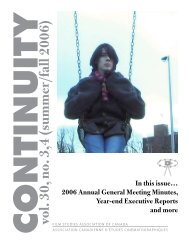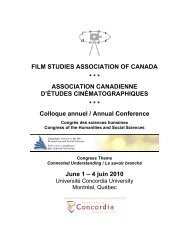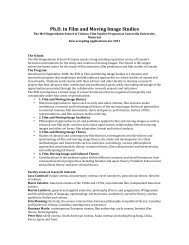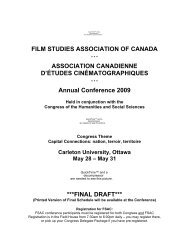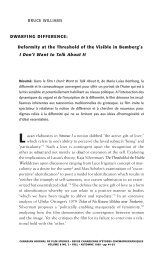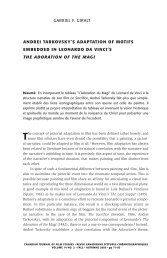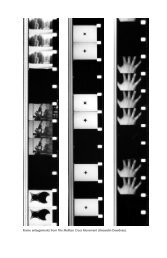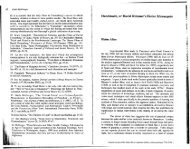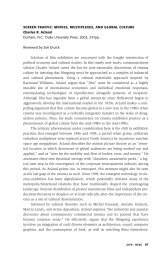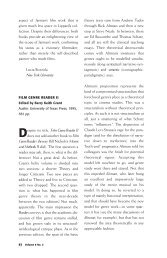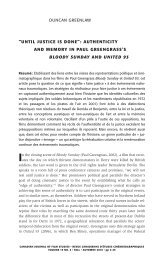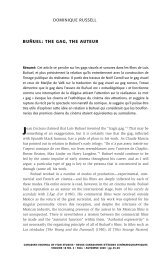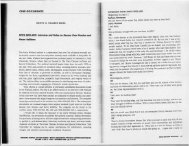cinematic experience, film space, and the child's world - Film Studies
cinematic experience, film space, and the child's world - Film Studies
cinematic experience, film space, and the child's world - Film Studies
You also want an ePaper? Increase the reach of your titles
YUMPU automatically turns print PDFs into web optimized ePapers that Google loves.
005.Kuhn.19.2:005.Kuhn. 11/18/10 5:32 PM Page 83<br />
psychodynamics, or <strong>the</strong> metapsychology, involved in <strong>the</strong> viewer’s encounter<br />
with cinema. The psychoanalytic ideas most commonly drawn on in <strong>the</strong>orizing<br />
<strong>the</strong> <strong>cinematic</strong> apparatus have been instinct or drive-based <strong>and</strong> have emphasized<br />
<strong>the</strong> centrality of scopophilia, or <strong>the</strong> drive to pleasurable looking. In consequence,<br />
such work has been focused largely on issues around <strong>the</strong> instrumentality of<br />
vision <strong>and</strong> spectatorship in <strong>the</strong> <strong>cinematic</strong> <strong>experience</strong>. In this approach, based<br />
ultimately on Freud’s thinking about <strong>the</strong> drives, unconscious processes are paramount.<br />
1 Here, however, a variant of object-relations psychoanalysis is drawn on,<br />
in which attachment is emphasized <strong>and</strong> in which <strong>the</strong> Unconscious assumes less<br />
importance in mental life. This model can shed light both on <strong>the</strong> <strong>world</strong> constructed<br />
by <strong>the</strong> <strong>film</strong> <strong>and</strong> on <strong>the</strong> <strong>experience</strong> of <strong>the</strong> viewer, whilst at <strong>the</strong> same time<br />
taking into account <strong>the</strong> materiality of cinema as a cultural medium whose distinctiveness<br />
lies in <strong>the</strong> ways it can create <strong>and</strong> organize spatiality <strong>and</strong> motion. It<br />
also presents a grounded, even an empirically testable, conceptualization of <strong>the</strong><br />
interplay between inner mental reality <strong>and</strong> outer material reality in <strong>the</strong> <strong>cinematic</strong><br />
<strong>experience</strong>, whilst opening up fresh strategies for reading <strong>film</strong>s.<br />
I<br />
Central to <strong>the</strong> object-relations approach pursued here are <strong>the</strong> concepts of transitional<br />
object, transitional phenomena <strong>and</strong> transitional process, introduced <strong>and</strong><br />
developed from <strong>the</strong> 1950s onwards by Donald Winnicott, a paediatrician <strong>and</strong> foremost<br />
representative of <strong>the</strong> British Independent tradition in object-relations psychoanalysis.<br />
Transitional objects, now common currency in thinking about infant<br />
<strong>and</strong> child development, are <strong>the</strong> first “not-me” possessions of infants <strong>and</strong> young<br />
children (a blanket, an old piece of cloth, a teddy). While transitional objects are<br />
exactly that—objects, things—<strong>the</strong> point about <strong>the</strong>m is that <strong>the</strong>y are pressed into<br />
<strong>the</strong> service of <strong>the</strong> child’s inner <strong>world</strong>. They belong, that is, to <strong>the</strong> child’s fantasy<br />
<strong>world</strong> while at <strong>the</strong> same time having a physical existence in <strong>the</strong> outer <strong>world</strong> of<br />
material objects. In terms of <strong>the</strong> child’s mental <strong>space</strong> <strong>and</strong> object-<strong>world</strong>, <strong>the</strong>n, <strong>the</strong><br />
transitional object is at one <strong>and</strong> <strong>the</strong> same time part of itself <strong>and</strong> not itself. Such<br />
objects inhabit an intermediate position between fantasy <strong>and</strong> reality, <strong>and</strong> this<br />
intermediate zone, according to Winnicott, is <strong>the</strong> place of imagination.<br />
Broadly speaking, this object-relations approach embodies several key<br />
attributes. Above all, perhaps, <strong>the</strong> central issue is not simply <strong>the</strong> objects <strong>the</strong>mselves<br />
(imaginary, “real,” or more likely a mix of <strong>the</strong> two) but equally, or more,<br />
significantly <strong>the</strong> <strong>space</strong>s between objects. Spaces are paradoxical, in that <strong>the</strong>y<br />
have <strong>the</strong> capacity at once to connect objects <strong>and</strong> to keep <strong>the</strong>m apart. Winnicott<br />
makes great play in his writings with terms that connote “betweenness,” terms like<br />
“transitional <strong>space</strong>” <strong>and</strong> “intermediate zone,” suggesting that transitional phenomena<br />
inhabit, <strong>and</strong> operate in, <strong>the</strong>se “<strong>space</strong>s between.” This sets up a highly fluid<br />
<strong>and</strong> dynamic model of <strong>the</strong> psyche <strong>and</strong> its formation <strong>and</strong> operation, one which<br />
also allows for <strong>the</strong> conceptualisation of a non-fixed <strong>and</strong> non-universalising<br />
CINEMATIC EXPERIENCE, FILM SPACE, AND THE CHILD’S WORLD 83



